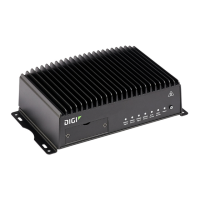IPv6 Prefix delegation
Digi TransPort WR Routers User Guide
69
Auto-configuration mode Description
SLAAC + DHCPv6 The device uses a combination of SLAAC
and DHCPv6. It uses SLAAC to auto-
configures itself with an IPv6 address,
and DHCPv6 to get other network
configuration, such as DNS server
information. This configuration mode is
available because earlier versions of the
Router Advertisement did not include
any DNS server information. Therefore
the device had to use DHCPv6 to get this
information.
Prefix delegation
Prefix delegation is how a router asks for a prefix from the ISP that it can subnet and distribute
through its LAN interfaces. Prefix delegation is an extension of the DHCPv6 protocol.
Normally, a router gets a /64-bit prefix using Router Advertisements, which cannot normally be
subnetted. Therefore, a router uses prefix delegation to request a globally routable prefix it can
distribute.
When the TransPort device receives a delegated prefix, it appends a subnet ID and assigns it to the
LAN interfaces with IPv6 enabled. The subnet ID differs for each LAN. By default, the subnet ID is the
LAN instance.
For example, if the delegated prefix is 2001:1234:5678:9ab0::/60, the prefixes for LANs 1 to 4 are:
n LAN 1: 2001:1234:5678:9ab1/64
n LAN 2: 2001:1234:5678:9ab2/64
n LAN 3: 2001:1234:5678:9ab3/64
n LAN 4: 2001:1234:5678:9ab4/64
The router’s LAN interfaces then advertise these prefixes using Router Advertisements and DHCPv6.
More information on IPv6
For more information, including key differences between IPv4 and IPv6, see this Digi white paper on
IPv6.
Configure a LAN for IPv6
Currently, the only mode for auto-configuration of devices connected on the LAN is DHCPv6.
Configuring a LAN for IPv6 involves Enable IPv6 on a LAN.
Enable IPv6 on a LAN
You can enable IPv6 on a per-LAN interface basis.
Enabling IPv6 on a LAN does not affect IPv4 operation. When IPv6 is enabled for a LAN, you can have
IPv4 addresses on the LAN and hosts on the LAN can use IPv4 and IPv6 as required.

